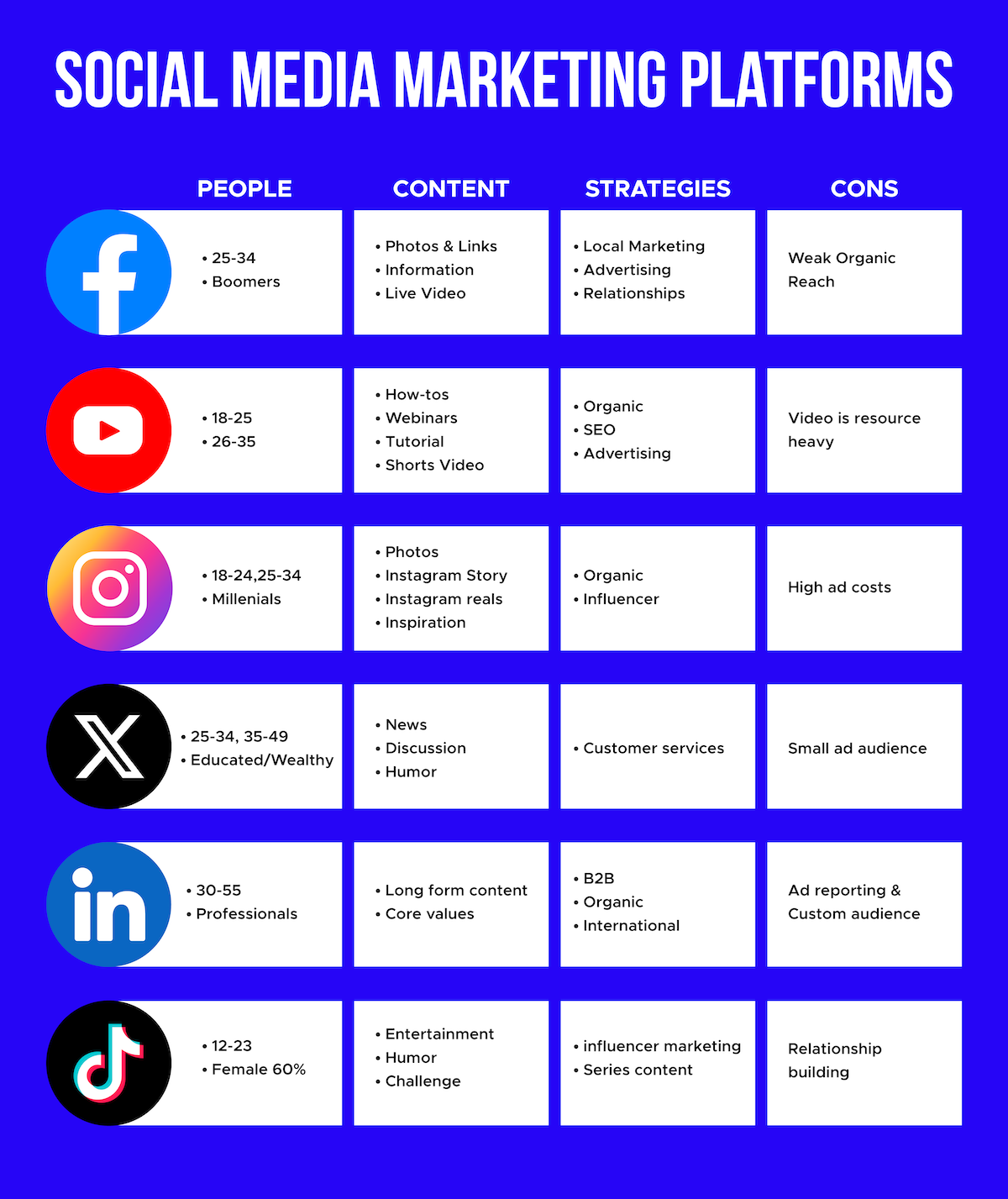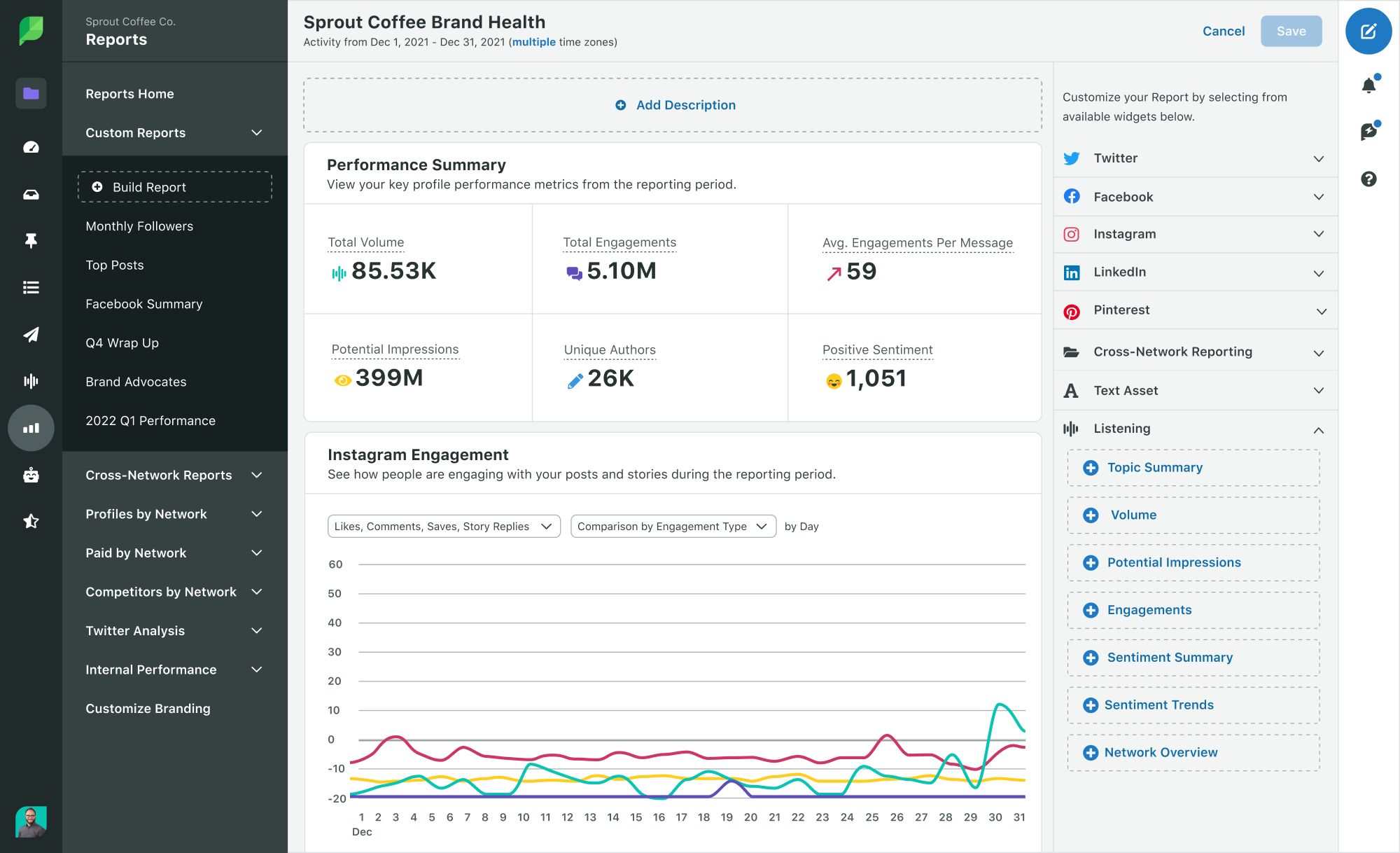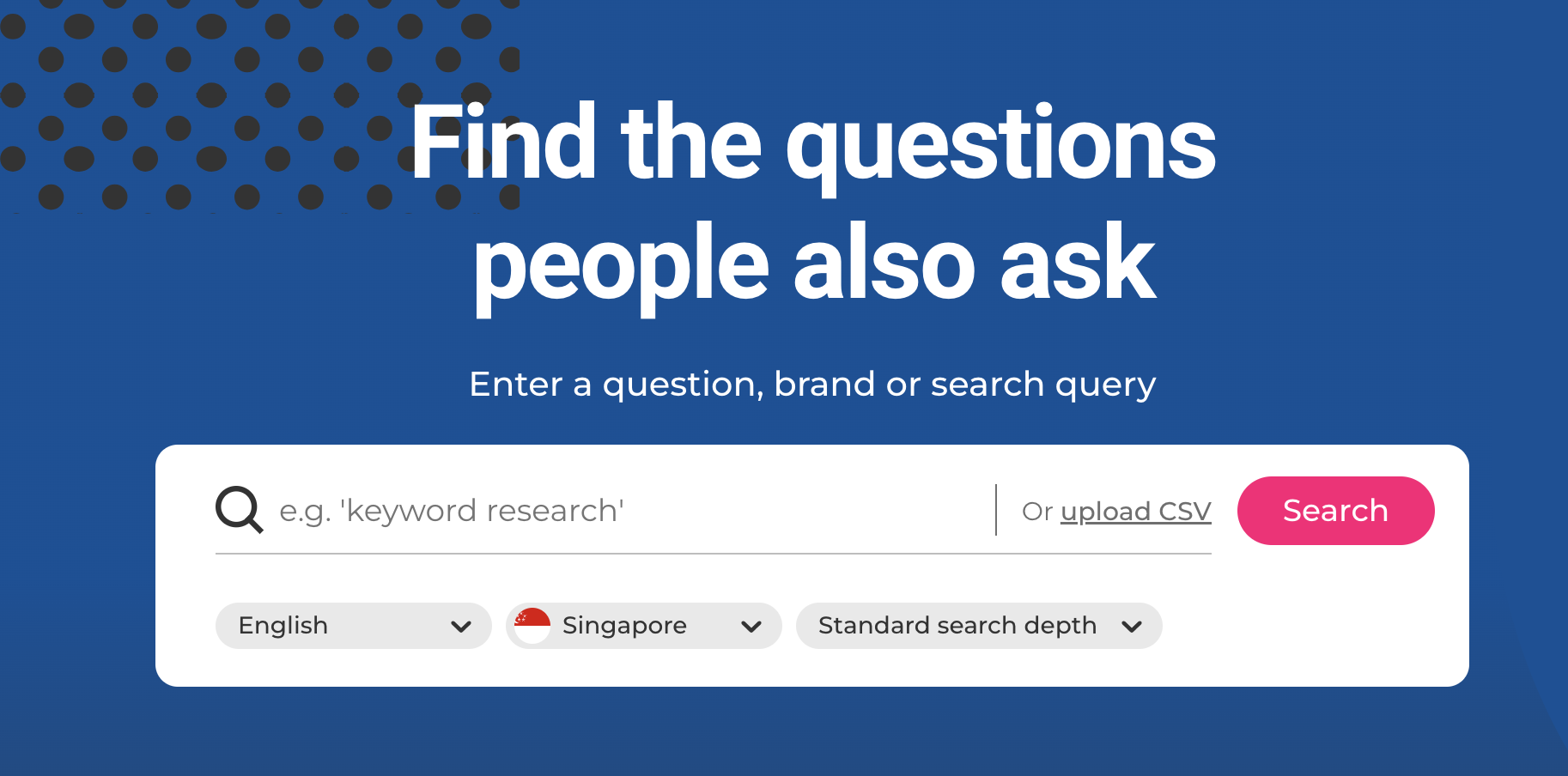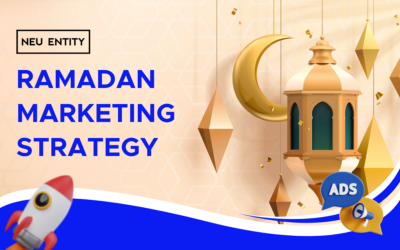Social Media Marketing Tips for Business Owner in 2024
Last Update: 22 November 2023
Looking to elevate your brand with cutting-edge social media marketing tips for 2024? As a crucial asset for businesses aiming to widen their influence and bond with their audience, social media marketing is more vital than ever.
This is precisely why we’ve crafted a detailed guide to building your social media marketing strategy from the ground up.
What is Social Media Marketing?
Social media marketing is a powerful tool for business owners looking to expand their reach, engage with customers, and grow their brand. It involves using social media platforms like Facebook, Instagram, Twitter, LinkedIn, and others to promote products or services, connect with potential and existing customers, and build a community around your brand.
1. Understanding Social Media Platforms and Audiences
It’s no secret that each social media platform attracts a distinct user base. For example, while Instagram is a haven for millennials and Gen Z, platforms like LinkedIn cater to professionals and business communities.
Understanding these nuances is crucial. As a business owner, diving into the demographics of these platforms can offer invaluable insights. It helps in crafting messages that speak directly to the interests and needs of your potential customers.

Facebook is often seen as a versatile platform with a broad age group, making it ideal for businesses targeting a wide demographic range.
Instagram and Snapchat are the go-to platforms for engaging with a younger audience, particularly for visually appealing products or services.
LinkedIn stands out for B2B marketing, with its professional user base.
TikTok, with its explosive growth, offers a unique space to connect with the younger generation through creative and trending content.
Tailoring Content and Platform Choice for Specific Audiences
Once you understand who you’re dealing with on each platform, the next step is tailoring your content. This is not just about tweaking the language or visuals but also involves aligning your brand’s message with the values and interests of your audience. For instance, content that works wonders on TikTok might not resonate as well with LinkedIn’s professional crowd.
For Example
A professional services firm, LinkedIn might be the ideal platform to share industry insights and thought leadership articles.
A lifestyle brand might find more engagement on Instagram and Pinterest through high-quality visuals and interactive stories.
If you want to target Gen Z that you need creating more video related content in Instagram Reels and Tiktok
2. Align Strategies with Business Goals
Aligning your online activities with your overarching business objectives is not just a good practice; it’s essential. It’s about ensuring that every tweet, post, and story contributes to your business’s broader goals.
Aligning Social Media Tactics with Business Objectives
The key to successful social media marketing is ensuring that your social media tactics feed directly into your business objectives.
Goal Example 1 : Brand Awareness
Brand awareness is all about making your presence known in the market. A significant 68% of consumers follow brands on social media primarily to keep up-to-date with new products or services, as highlighted by The Sprout Social Index™. This statistic underscores the importance of leveraging social media as a key channel for introducing and promoting new offerings to an engaged audience.
If your goal is brand awareness, prioritize creating shareable and visually engaging content.

For example content provided by Neu Entity, they showcase a unique blend of insights, featuring both a glimpse into the company’s daily activities and educational material relevant to their industry. This approach not only humanizes the brand but also positions it as a knowledgeable source within its sector, engaging their audience with a mix of behind-the-scenes looks and informative content.
Goal Example 2: Sales Objectives
For sales objectives, focus on creating content that guides followers from awareness to purchase, such as showcasing products, sharing customer testimonials, and providing direct links to your e-commerce platform.

Setting Social Media Goals and KPIs
Whether it’s increasing brand visibility, boosting sales, or enhancing customer engagement, each goal should be specific, measurable, attainable, relevant, and time-bound (SMART). For a business owner, this clarity transforms social media from a casual activity into a focused strategy.
Increase Brand Awareness: This could involve tracking metrics like follower growth, reach, and impressions.
Improve Community Engagement: Engagement rates, comments, and shares can be effective indicators.
Drive Online Sales: Monitor referral traffic from social media platforms to your website and track conversion rates.
In essence, aligning your social media strategy with your business goals is about creating synergy between your online presence and your overall business objectives. It’s about making every post, every interaction, and every campaign part of a larger story – the story of your brand’s journey towards its goals.
3. Content Creation and Consistency
A staggering 96% of marketing decision-makers currently affirm the effectiveness of content marketing for their brands, as reported by Zazzle Mediain.That why Important for your business in 2024 to create powerful content because content is king. However, the creation of this content and the consistency with which it’s posted can make or break your social media strategy.
Planning and Scheduling Content
Strategic Content Creation
Content creation for social media should be a strategic process. It’s not just about what you post, but also when and how often. This approach ensures that your content is aligned with your brand’s messaging and marketing objectives.
Batch Content Creation: Designate specific times for content creation to maintain a steady flow of posts without disrupting your daily workflow.
Content Calendar: A well-planned content calendar helps in scheduling posts for optimal times across different platforms.
Scheduling for Optimal Impact
Understanding the best times to post on each platform is crucial. Each social media channel has unique peak hours where your audience is most active and engaged.
For B2B Brands: Platforms like LinkedIn might perform best during business hours.
For B2C Brands: Instagram and Facebook might see higher engagement during evenings and weekends.
Consistency in Posting
Platform-Specific Posting Strategies
Each social media platform has its rhythm and requirements for posting frequency.
Twitter and Instagram Stories: These platforms may require multiple posts per day to stay relevant.
Regular Instagram Posts and Facebook Updates: These might not need as frequent posting but should maintain a consistent schedule.
4. Keeping an Eye on What’s Trending
Staying updated with the latest trends is crucial for maintaining relevance in social media. However, it’s important to discern which trends align with your brand’s messaging and values.
You can use those tools to check what trending on social media
1. Sproutsocial

This tool help your business with track consumer behavior as it relates to specific topics to stay up to date with trends in your industry.
2. Google Trends

Google Trends, a complimentary resource, offers marketers and business owners valuable insights into trending topics derived from social media search activities. This tool aids in shaping content strategies by offering data on annual and monthly trends, revealing what topics are gaining interest online.
3. AlsoAksed

AlsoAsked is a tool that goes beyond surface-level queries by delving into related sub-questions users might be seeking answers to. This deeper exploration offers an overview of the subject and its implied intent, aiding you in positioning your content to deliver maximum value at specific stages of a customer’s conversion journey. By understanding and addressing these sub-questions, your content becomes more targeted and effective in guiding potential customers through their decision-making process.
5. Building and Engaging with Your Community
Social media is not just about broadcasting content; it’s about fostering a sense of community among your followers. This involves interactive and engaging content that encourages participation.
Interacting with Your Audience
Regular interaction with your audience helps in building a loyal and engaged community. This includes acknowledging comments, sharing user-generated content, and participating in relevant conversations.
Engagement Strategies:
Use polls, Q&A sessions, and user-generated content to involve your audience actively in your brand’s narrative.
Community Groups:
Consider creating or joining community groups relevant to your industry on platforms like Facebook and LinkedIn.
Responsive Interaction:
Promptly respond to comments and messages to show your audience that you value their engagement.
User Appreciation:
Show appreciation for active followers and contributors, fostering a stronger connection with your community.
6. Measuring and Analyzing Results
Tracking Social Media Efforts
Understanding the impact of your social media activities is crucial for refining and optimizing your strategy. This involves identifying key metrics and regularly analyzing them.
Metrics Identification: Identify key performance indicators (KPIs) such as engagement rates, reach, impressions, and conversion rates.
Regular Analysis: Conduct weekly, monthly, and quarterly analyses to track progress and identify areas for improvement.
Tools to help your analyzing social media
1. Sproutsocial
Sprout’s analytics tools offer profound insights, enabling you to understand what truly engages your customers, identify emerging market trends, and demonstrate the return on investment (ROI) of your social media efforts.
2. Metricool
Metricool offers a range of features to enhance social media management. Users can schedule content for months in advance, select optimal posting times and hashtags, approve scheduled content, and measure results through intuitive graphs.
7. Investing in Video Content
Video content has experienced a surge in popularity on social media, becoming a vital part of contemporary social media strategies.
As per Statista’s data, in 2022, there were over three billion internet users engaging with streaming or downloaded video content monthly. This figure is expected to grow each year, with projections suggesting it will near 3.5 billion by 2023.
Tips for Investing in Video Content
1. Understand Platform Specifics
Each social media platform favors different types of video content. For example, Instagram and TikTok are great for short, engaging clips, while YouTube is better suited for longer, more detailed content.
2. Focus on Storytelling
Use video to tell your brand’s story in an engaging way. This could be through customer testimonials, behind-the-scenes glimpses, or showcasing how your products are made.
3. Create Educational Content
Videos that educate or provide value to your audience can significantly boost engagement. How-to guides, tutorials, and informative content about your industry are highly effective.
4. Leverage Live Video
Platforms like Facebook and Instagram offer live video options, which are great for Q&A sessions, product launches, or live events. Live videos also offer high engagement rates.
5. Optimize for Silent Viewing
Many users watch videos without sound, especially on mobile devices. Ensure your videos are understandable without sound, using captions or on-screen text.
8. Partnering with Influencers
Collaborating with influencers can greatly boost your brand’s visibility and trustworthiness. According to a HubSpot consumer trends survey, 31% of social media users prefer learning about new products through influencers they follow, more than any other medium.
This preference is even more pronounced among Gen Z consumers, with 43% favoring influencers for discovering products. Influencer marketing thus emerges as an effective strategy, especially for targeting the Gen Z demographic. However, the success of such collaborations hinges on selecting influencers who resonate with your brand’s values and ethos, ensuring authenticity and a stronger connection with your target audience.
Tips for choosing Influencers
Influencer Selection:
Look for influencers who resonate with your brand and have a genuine connection with their audience.
Authentic Promotion:
Work with influencers to create content that feels organic and authentic, enhancing trust among their followers.
9. Hiring a Social Media Agency
Hiring a social media agency can provide a wealth of benefits, from expert insights and time savings to tailored strategies and measurable results.
It’s an investment that can significantly enhance your brand’s online presence and engagement. Here’s why it can be a game-changer for your social media marketing strategy.
Professional Insights
A social media agency brings a wealth of knowledge and expertise to the table. They are equipped with insights into the latest trends, algorithms, and strategies that can significantly enhance your online presence.
Time and Resource Efficiency
By outsourcing your social media marketing, you can free up valuable time and resources to focus on core business activities.
Time-Saving: Agencies handle the day-to-day management of your social media, allowing you to dedicate more time to running your business.
Resource Allocation: Reduce the need for in-house resources dedicated to social media, potentially lowering your operational costs.
Tailored Approach
Social media agencies can develop customized strategies that align with your business goals and brand identity.
Conclusion
In conclusion, as we look towards 2024, it’s clear that social media marketing will continue to be an indispensable part of a business’s growth strategy. The landscape of social media is ever-evolving, with new platforms emerging and audience preferences shifting. It’s crucial for business owners to stay ahead of these changes and adapt their strategies accordingly.
For business owners aiming to refine their social media strategies and stay competitive in the dynamic digital landscape, it’s essential to have a partner who understands these nuances. At Neu Entity, we specialize in crafting bespoke social media strategies that align with your unique business goals. We’re here to help you harness the power of social media and propel your business forward in 2024 and beyond.
Remember, the journey of social media marketing is continuous and ever-changing. Embrace these changes with the right strategies and partnerships, and watch your business thrive in the digital world.
Related Articles
Let’s Talk!
If what you see here is relevant for you and can help you grow your business or organisation, we’d love to discuss further with you. Drop us a message or schedule an appointment with us.




